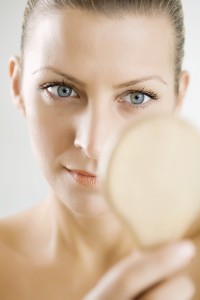Permanent cosmetics offer women the appearance of facial makeup without the daily chore of applying it. The idea is enticing to most, but apprehensions and reservations exist about a “permanent” makeup solution. For select applications, permanent cosmetics do offer freedom from this necessary evil but certain things should be considered before submitting to the procedure.
The best results of permanent cosmetics are those that mimic eyeliner. Most women can live with the permanence of permanent eyeliner—it is black and always in the same location. Eyeliner is also one of the least favorite parts of the makeup application process since it requires accurate work and patience.
Another popular permanent cosmetic is lip liner. Lip liner application is another process that requires careful work. Also, properly applied permanent cosmetics as lip liner can give the lips a fuller appearance. Unfortunately women run into an issue of color choice, here. Fortunately if a woman with permanent lip liner wants a different color, regular makeup can be applied over the permanent cosmetics.
While it has been tried, using permanent cosmetics for other applications like eye shadow and blush have not been as cosmetically favorable. Many professionals will not offer these options because of the highly variable results. The permanent cosmetic process does not always allow for adequate blending yielding a “clown” look. If you are considering these forms of permanent cosmetics you should ask to see real before and after photos to judge the quality of a provider’s work.
A discussion of permanent cosmetics must include a discussion of true permanent cosmetics and a “semi-permanent” alternative that is sometimes confused with the permanent approach. Permanent cosmetics are, in many ways, similar to a tattoo. Small particles of pigment are injected into the skin in a process that professionals called micropigmentation.
Like tattoos, the skin does not destroy or expel the pigment and the color can be seen on the skin. High quality micropigmentation processes are essentially permanent and will fade only slightly, if at all, over time. The pigments are chosen for their ability to produce a particular color and have long-lasting results.
The term “semi-permanent” cosmetic has been used to describe either cosmetics that are not very soluble in water and do not come off during normal wear. These makeup options are still makeup and can be removed with makeup remover. They will also wear away in a few days at best. The other “semi-permanent” cosmetic option is a bit more insidious because it has been used to describe a process that is similar to permanent cosmetics with inferior results.
The pigments used in this approach may fade or change color over time. The term “semi-permanent” has been used to attract women to the procedure that fear a permanent change in their face. In some instances, “semi-permanent” is actually quite permanent. In others, the faded color persists, but it is not what the client wanted.
Another thing to consider about permanent cosmetics is that they can be applied by a number of people, from plastic surgeons to tattoo artists. Your state may regulate these professionals and it may not which means that you will need to check on a few things.
How does the provider sterilize their equipment? Permanent cosmetics are applied with needles—needles that could transmit serious infections to you if they are not properly cleaned and sterilized. Most places are good about this, but sterilization is expensive so it becomes a way to cut corners. Make sure that your procedure is clean.
Also, medical professionals can offer local and topical anesthetic while non-medical professionals may not. They may be able to provide allergy testing as well. An allergic reaction to permanent cosmetics can become a serious medical problem.
